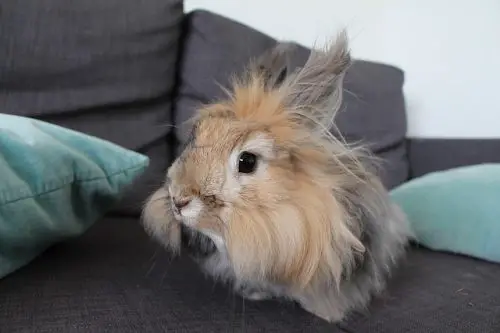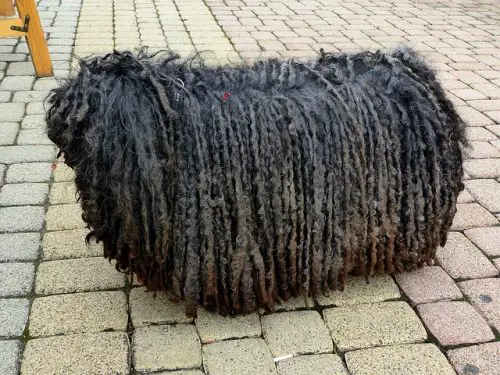Most animals are blessed with hairs and furry coats that serve various purposes. However, there are some animals with very funny hair, that leaves most people wondering if there’s a mistake in their genome. Some of these hairs would be better fits on human beings than on animals.
Yet, these animals don’t need hairstyles to make them unique — they stand out with their natural hair, and some of them are just hilarious.

Some Animals with Funny Hair
Angora Rabbits
Angora rabbits are bred for their soft, thick fur. So what makes them different from other animals bred for fur like sheep? Well, the fur of Angora rabbits can grow to enormous proportions, making them look like large living cotton balls. Angora rabbits can’t groom their fur themselves, so if left alone, their fur will keep growing. Their hairs can grow up to three centimeters per month.
This is one of the reasons why Angora rabbit fur is quite popular. They also come in different colors, like brown, white, and grey. Angora rabbits are one of the oldest types of domestic rabbits. It’s a relief they’re not extinct — You don’t find living cotton balls everywhere, especially one that produces a lot of furs.
Afghan Hounds
Afghan hounds are dogs with long fine silky hair. They are one of the oldest pure breeds and are thought to have originated from Afghanistan, hence their name. Their hair is so long and beautiful, that it wouldn’t look bad on a human head. Afghan hounds wouldn’t be bad options for modeling, but don’t be deceived.
These dogs were originally used for hunting large prey, and their hair isn’t just for show. Their thick fur was very necessary for the cold mountains of Afghanistan. Yet, this doesn’t out rule the fact that when properly groomed, their hairs are quite lovely; and what’s more, they can grow to floor length.
Lionhead Rabbits
Lionhead rabbits originated in France and Belgium. As its name implies, a wool mane grows around the head of the rabbits. Though they have a wool mane, their temperaments are far from fierce. Lionhead rabbits are calm, affectionate, and timid, nothing like a brave ferocious lion.
Lionhead rabbits are classified based on the nature and feature of their manes into single maned and double maned lion head rabbits. Single maned rabbits lose their manes as they grow older. Their manes are usually thin and wispy.
Unlike single maned lionhead rabbits, double maned lionhead rabbits do not lose their manes. Also, the mane of double maned lionhead rabbits covers their head and flanks — their manes cover greater areas than single maned lionhead rabbits.
Flannel Moth Caterpillars
Flannel Moth caterpillars are the larvae of the beautiful flannel moths. These caterpillars are covered with white, silky hairs. They look quite harmless, but there’s a catch. Hidden among their numerous hairs are stinging hairs with deadly venom.
These stinging hairs laced with venom can cause rashes, lesions, and even nausea. In fact, flannel moth caterpillars are regarded as one of the deadliest caterpillars in the world, and their trump card is hidden between their fuzzy hairs. Brushing these caterpillars could even cause sting hairs to break off and pierce the skin.

Mop Dogs
These dogs are also known as Komondors, or Hungarian sheepdogs, are livestock guardian dogs native to Hungary. Their body is covered with long, creased, white dreadlocks that resemble the strings of yarn attached to mop heads.
When these dogs lie down, their hairs rest on the floor, just like mop heads. It’s not difficult to decipher how they got their name, they’re literally walking mops. Their thick coat protects them from the bites and scratches of other animals.
Pulis
Pulis are medium-sized dogs native to Hungary. Like Komondors, they are also livestock guardian dogs. Their body is covered with a thick coat consisting of long creased hairs, similar to dreadlocks. Unlike the Komondors, their hairs are usually black, or grey.
White-haired pulis aren’t very common. With their thick, long hairs, pulis look like a thick mass of yarn, especially when their hairs aren’t properly groomed. The thickness of these strands of hair varies among the pulis. Their hairs can grow quite long, to floor-length. Take away their size and color, and they’d look exactly like mop dogs.
Yeti Crabs
Yeti crabs are crustaceans native to the South Pacific Ocean. These crabs get their name from the silky hairs, known as setae covering their pereiopods (thoracic legs), which resemble the hairs of the mythical snow monster, the yeti. They are literally blind — their eyes are barely functional.
These yeti-like hairs on the thoracic legs of yeti crabs are very crucial to their survival. The hairs capture different bacteria, which then live and thrive on them. These bacteria serve as an important food source, and they also detoxify poisonous minerals that are emitted by hydrothermal vents.

Hairy Frogfishes
This is a type of fish that is covered in hair-like spines. These hair-like protrusion help these fishes to blend with their environment, which is usually against corals and seaweeds. These spines also help hairy frogfishes to catch prey. They have a long worm-like spine on their dorsal fins, that attracts prey.
Mary River Turtles
Mary river turtles are large turtles native to Queensland Australia. Mary river turtles have green hair and whiskers usually in the shape of a mohawk. However, these hairs are nothing but algae that grow on their hairs and shells.
Mary river turtles can stay underwater for over two days. During this time, they breathe through their cloaca — an opening with functions similar to the anus in human beings.
Shih Tzu
Shih Tzu is a type of dog with elegant flowing hair that can reach floor length. Shih Tzu has hair similar to that of human beings. Their hairs can grow to lengths that cover their legs, making them seem like they float rather than walk. Like Afghan hounds, they’d also make good models, if their hairs are properly groomed.
